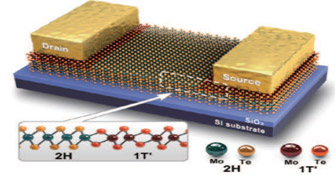- News
19 August 2015
2D transistor made from dual-phase transition-metal dichalcogenide crystal
A multi-disciplinary research team led by Young Hee Lee, director of South Korea's Institute for Basic Science (IBS) Center for Integrated Nanostructure Physics at Sungkyunkwan University (SKKU), has devised a fabrication method for the creation of pure molybdenum ditelluride (Suyeon Cho et al, 'Phase patterning for ohmic homojunction contact in MoTe2', Science (2015) vol. 349, no. 6248, p625).

Figure 1. Top, 2H-MoTe2 Bottom, 1T--MoTe2[1].jpg
Figure 1. Top, 2H-MoTe2 Bottom, 1T'-MoTe2.
Molybdenum ditelluride (MoTe2) is a crystalline compound that, if pure enough, can be used as a transistor. Its molecular structure is a sandwich made up of one molybdenum atom for every two tellurium atoms. It was first made in the 1960s via several different fabrication methods, but had never been made in a pure enough form to be suitable for electronics.
Not only did the IBS-led team succeed in making MoTe2 in pure form, they were also able to make two types of it — the semiconducting variety 2H (hexagonal) and the metallic variety monoclinic 1T' (octahedral) of MoTe2 — which are both stable at room temperature.
Making MoTe2 in a pure form was very difficult and was seen by some as a black sheep of the transition-metal dichalcogenides (TMD) family and hence ignored. TMDs are molecules that can be made very thin (just several atomic layers thick) and have an energy bandgap that makes them ideal for making electrical components, especially transistors.
A TMD crystal follows an MX2 format: there is one transition metal (where M can be tungsten, molybdenum, etc) and two chalcogenides (where X2 is sulfur, selenium or tellurium). These atoms form a thin, molecular sandwich with the one metal and two chalcogenides, and (depending on their fabrication method) can exist in several slightly differently shaped atomic arrangements.
As electronic devices get smaller there is increasing demand to shrink the size of their logic chips. As the chips approach single or several atom thickness (i.e. two-dimensional), silicon no longer works as well as it does in a larger, three-dimensional scale. As the scale approaches two dimensions (2D), the bandgap of silicon changes (to a higher bandgap than that in its 3D form) and the contact points with metal connections on silicon are no longer smooth enough to be used efficiently in electrical circuits.
This is the perfect opportunity to employ new TMD materials. The IBS research team was able to exploit the two versions of MoTe2 and make one 2D crystal that was composed of the semiconducting 2H-MoTe2 and the metallic 1T'-MoTe2. This configuration is superior to using silicon as well as other 2D semiconductors because the boundary where the semiconducting (2H) and metallic (1T') MoTe2 meet forms an ohmic homojunction (a connection formed at the boundary between two different structural phases in a single material). Despite one MoTe2 state being a semiconductor and one being metallic, the team was able to create an ohmic homojunction between them, making an extremely efficient connection.
To do this, the team started with a piece of their pure 2H-MoTe2 that was several atoms thick. They directed a 1µm-wide laser at it, which locally heated the sample and changed the affected area into 1T'-MoTe2. The team was hence able to create a 2D transistor that utilized an amalgamation of both the semiconducting properties of 2H-MoTe2 and the high conductivity of 1T'-MoTe2.

Figure 2. Simulation of the process of converting the 2H-MoTe2 into 1T'-MoTe2 with laser-irradiation.
This presents a solution to several problems that have been a hindrance in the past. By using only one material in the device channel and the metal-semiconductor junction, it is more energy efficient since the joints between the two phases of the MoTe2 are fused seamlessly, realizing an ohmic contact at the joints. Because 1T'-MoTe2 is such a good conductor, metal electrodes can be applied to it directly, saving any additional work of finding a way to attach metal leads. This new fabrication technique is a very efficient way of utilizing the available MoTe2 without any wasted or extraneous parts.
 Figure 3. 2H-MoTe2 and 1T'-MoTe2 transition line and metal electrodes attached to the 1T'-MoTe2.
Figure 3. 2H-MoTe2 and 1T'-MoTe2 transition line and metal electrodes attached to the 1T'-MoTe2.
"There are many candidates for 2D semiconductors, but MoTe2 has a bandgap of around 1eV, which is similar to silicon's bandgap and it allows an ohmic homojunction at the semiconductor-metal junctions," says SKKU professor Heejun Yang. So, MoTe2 can replace silicon without much change in the current voltage configurations used with today's silicon technologies. The dual-phase MoTe2 transistor looks promising for use in new electronic devices as demand for components increases for materials that are small, light and extremely energy efficient.
transition-metal dichalcogenide
www.sciencemag.org/content/349/6248/625


